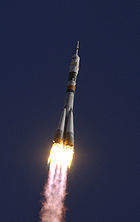Soyuz/Vostok
This article needs additional citations for verification. (December 2009) |
This rocket article contains payload capacity, but does not include orbital altitude or inclination, which greatly affects the capacity. |
| Has use | Interim carrier rocket |
|---|---|
| Manufacturer | OKB-1 |
| Country of origin | Soviet Union |
| Size | |
| Stages | Three |
| Capacity | |
| Payload to LEO | |
| Mass | 4,500 kilograms (9,900 lb) |
| Associated rockets | |
| Family | R-7 |
| Launch history | |
| Status | Retired |
| Launch sites | Baikonur 31/6 |
| Total launches | 2 |
| Success(es) | 2 |
| First flight | 27 December 1965 |
| Last flight | 20 July 1966 |
| People or cargo transported | US-A |
| Boosters – Block A/B/V/G | |
| No. boosters | 4 |
| Powered by | 1 RD-107 |
| Maximum thrust | 994.3 kilonewtons (223,500 lbf) |
| Specific impulse | 315 sec |
| Burn time | 118 seconds |
| Propellant | RP-1/LOX |
| First stage – 11S59 | |
| Powered by | 1 RD-108 |
| Maximum thrust | 977.7 kilonewtons (219,800 lbf) |
| Specific impulse | 315 sec |
| Burn time | 292 seconds |
| Propellant | RP-1/LOX |
| Second stage | |
| Powered by | 1 RD-0109 |
| Maximum thrust | 54.5 kN |
| Burn time | 365 seconds |
| Propellant | RP-1/LOX |
| Third stage – Unknown | |
The Soyuz/Vostok, also known as just Soyuz or Vostok, or by its GRAU index, 11A510 was an interim expendable carrier rocket used by the Soviet Union in 1965 and 1966. Two were launched with prototype US-A satellites.[1]
The Soyuz/Vostok was launched from Site 31/6 at the Baikonur Cosmodrome. It consisted of the first stage and boosters from a Soyuz rocket combined with the second stage of the Vostok-2, and an unknown third stage.[1] Along with the Voskhod-derived Polyot, it was built as an interim between the cancellation of the UR-200 development programme, and the introduction of the Tsyklon-2, which took over US-A launches once it entered service.
References[]
- ^ a b Wade, Mark. "Soyuz". Encyclopedia Astronautica. Archived from the original on 2010-01-17. Retrieved 2009-04-15.
Categories:
- Space launch vehicles of the Soviet Union
- R-7 (rocket family)
- Vehicles introduced in 1965
